Occupational Health Management: Noise Pollution in the Mining Industry
VerifiedAdded on 2023/03/29
|13
|2799
|434
Report
AI Summary
This report focuses on occupational health management within the mining industry, specifically addressing the hazard of noise exposure. It begins with an executive summary, then introduces the issue, defines relevant terms, and outlines the occupational demography of the mining sector. The report assesses the risks associated with noise pollution, including hazard identification and the potential health impacts on workers, such as hearing loss and emotional stress. It then explores legal requirements and ethical considerations, including the need for environmental assessments and the provision of personal protective equipment. A review of existing literature supports the analysis. The report proposes a comprehensive management plan that encompasses noise source control, path control, and receiver protection through engineering, administrative, and personal protective measures. The plan includes an emergency response component and a method for evaluation. The conclusion summarizes the key findings and recommendations for mitigating noise pollution and protecting the health of mining workers.
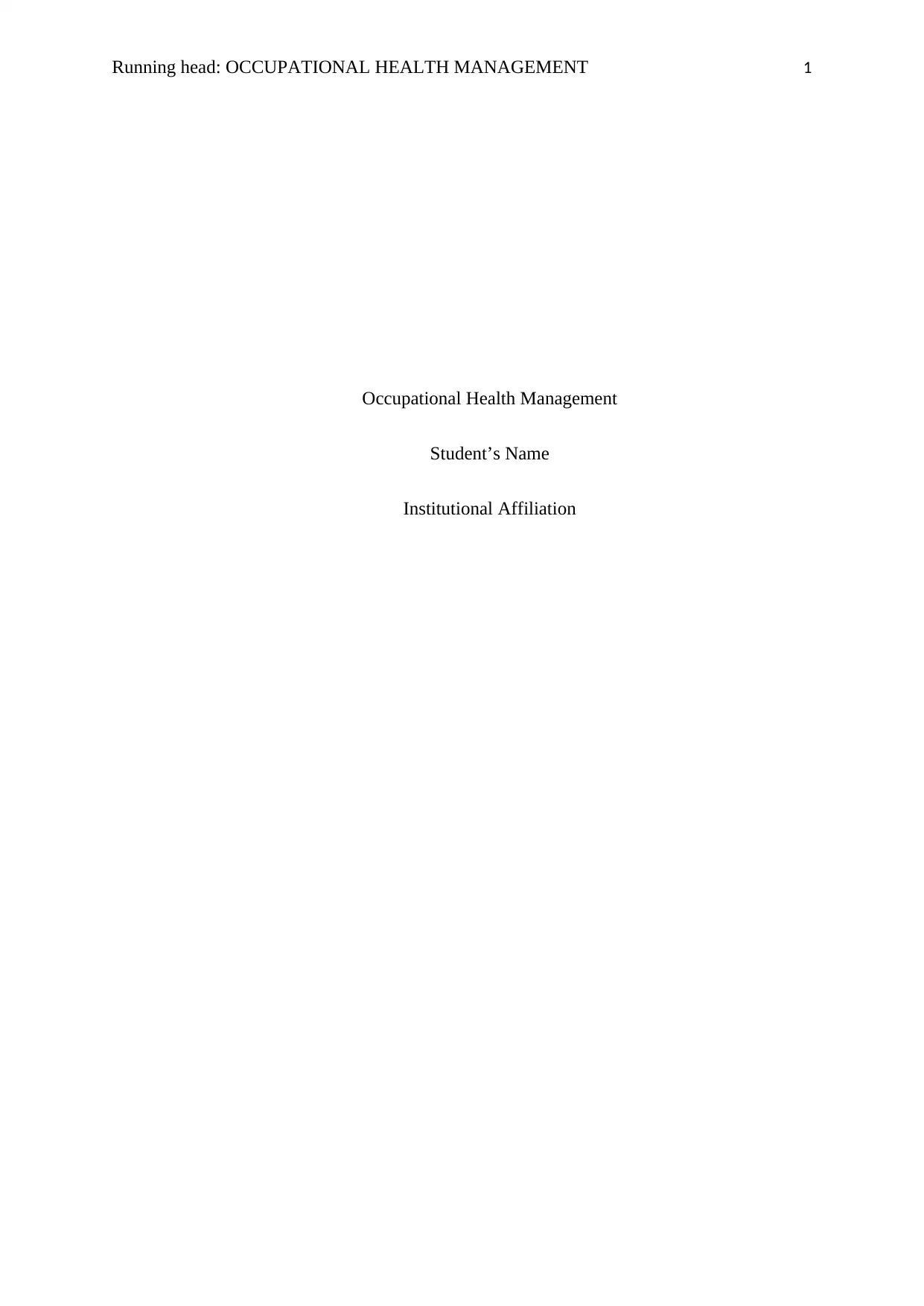
Running head: OCCUPATIONAL HEALTH MANAGEMENT 1
Occupational Health Management
Student’s Name
Institutional Affiliation
Occupational Health Management
Student’s Name
Institutional Affiliation
Paraphrase This Document
Need a fresh take? Get an instant paraphrase of this document with our AI Paraphraser
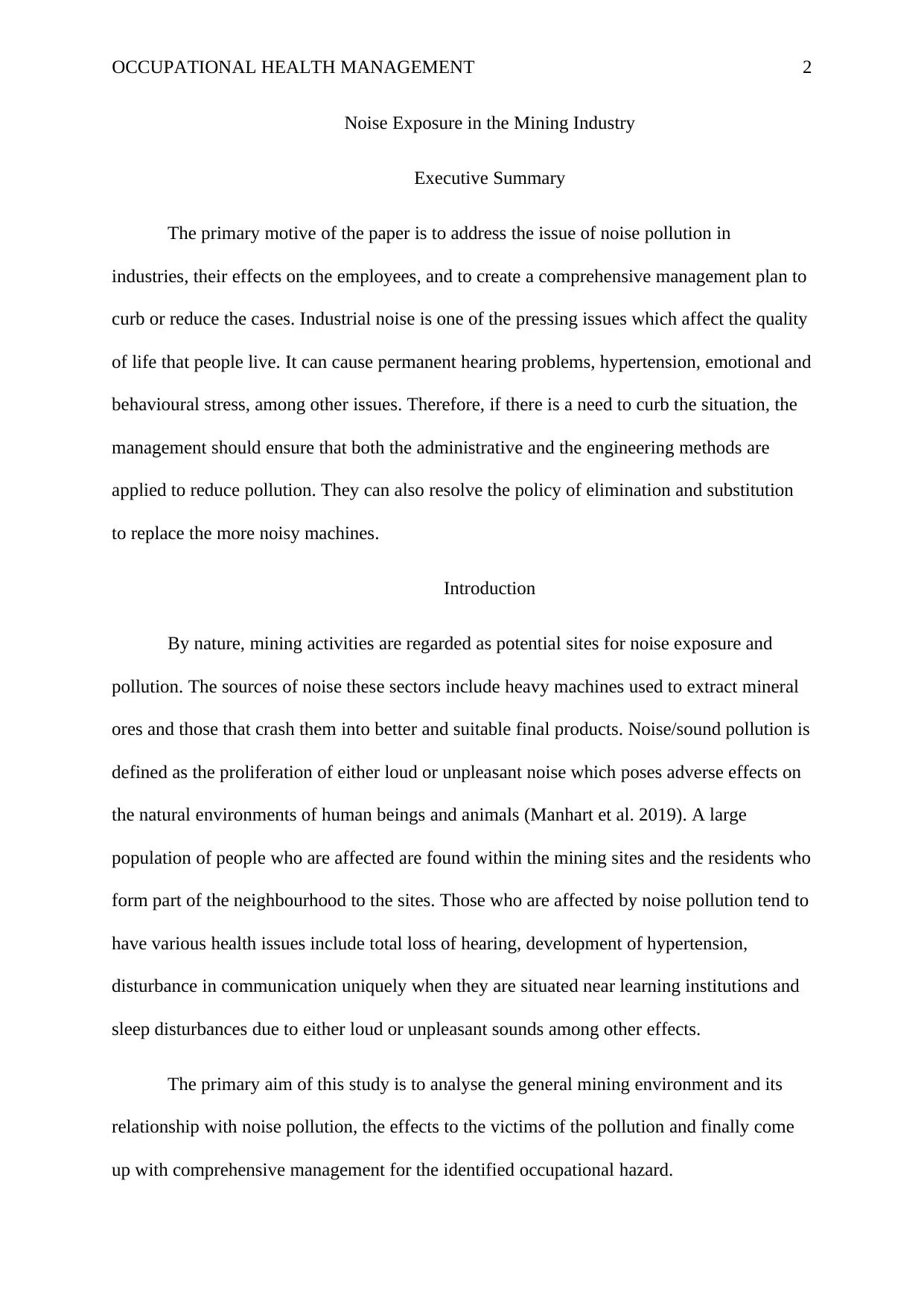
OCCUPATIONAL HEALTH MANAGEMENT 2
Noise Exposure in the Mining Industry
Executive Summary
The primary motive of the paper is to address the issue of noise pollution in
industries, their effects on the employees, and to create a comprehensive management plan to
curb or reduce the cases. Industrial noise is one of the pressing issues which affect the quality
of life that people live. It can cause permanent hearing problems, hypertension, emotional and
behavioural stress, among other issues. Therefore, if there is a need to curb the situation, the
management should ensure that both the administrative and the engineering methods are
applied to reduce pollution. They can also resolve the policy of elimination and substitution
to replace the more noisy machines.
Introduction
By nature, mining activities are regarded as potential sites for noise exposure and
pollution. The sources of noise these sectors include heavy machines used to extract mineral
ores and those that crash them into better and suitable final products. Noise/sound pollution is
defined as the proliferation of either loud or unpleasant noise which poses adverse effects on
the natural environments of human beings and animals (Manhart et al. 2019). A large
population of people who are affected are found within the mining sites and the residents who
form part of the neighbourhood to the sites. Those who are affected by noise pollution tend to
have various health issues include total loss of hearing, development of hypertension,
disturbance in communication uniquely when they are situated near learning institutions and
sleep disturbances due to either loud or unpleasant sounds among other effects.
The primary aim of this study is to analyse the general mining environment and its
relationship with noise pollution, the effects to the victims of the pollution and finally come
up with comprehensive management for the identified occupational hazard.
Noise Exposure in the Mining Industry
Executive Summary
The primary motive of the paper is to address the issue of noise pollution in
industries, their effects on the employees, and to create a comprehensive management plan to
curb or reduce the cases. Industrial noise is one of the pressing issues which affect the quality
of life that people live. It can cause permanent hearing problems, hypertension, emotional and
behavioural stress, among other issues. Therefore, if there is a need to curb the situation, the
management should ensure that both the administrative and the engineering methods are
applied to reduce pollution. They can also resolve the policy of elimination and substitution
to replace the more noisy machines.
Introduction
By nature, mining activities are regarded as potential sites for noise exposure and
pollution. The sources of noise these sectors include heavy machines used to extract mineral
ores and those that crash them into better and suitable final products. Noise/sound pollution is
defined as the proliferation of either loud or unpleasant noise which poses adverse effects on
the natural environments of human beings and animals (Manhart et al. 2019). A large
population of people who are affected are found within the mining sites and the residents who
form part of the neighbourhood to the sites. Those who are affected by noise pollution tend to
have various health issues include total loss of hearing, development of hypertension,
disturbance in communication uniquely when they are situated near learning institutions and
sleep disturbances due to either loud or unpleasant sounds among other effects.
The primary aim of this study is to analyse the general mining environment and its
relationship with noise pollution, the effects to the victims of the pollution and finally come
up with comprehensive management for the identified occupational hazard.
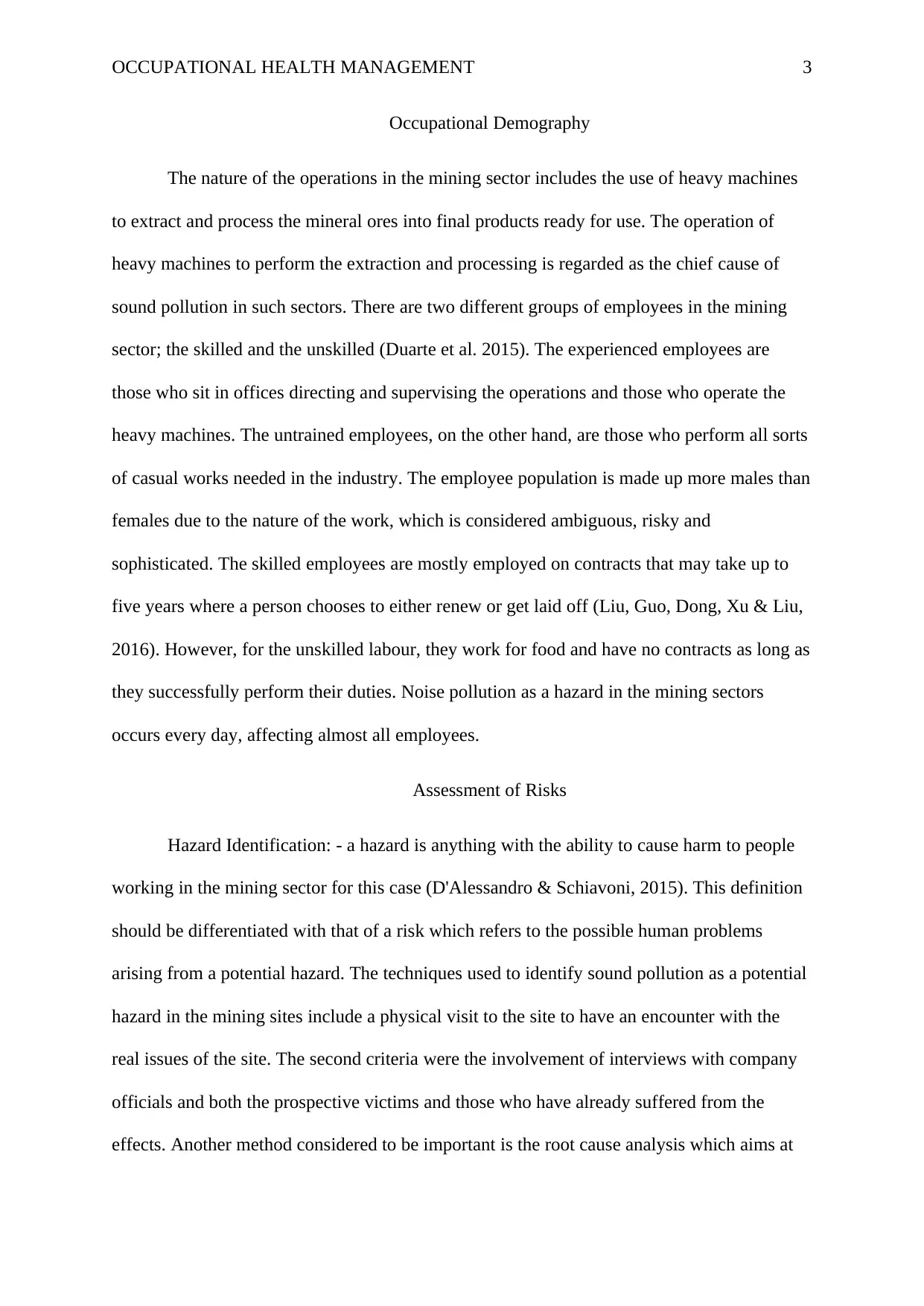
OCCUPATIONAL HEALTH MANAGEMENT 3
Occupational Demography
The nature of the operations in the mining sector includes the use of heavy machines
to extract and process the mineral ores into final products ready for use. The operation of
heavy machines to perform the extraction and processing is regarded as the chief cause of
sound pollution in such sectors. There are two different groups of employees in the mining
sector; the skilled and the unskilled (Duarte et al. 2015). The experienced employees are
those who sit in offices directing and supervising the operations and those who operate the
heavy machines. The untrained employees, on the other hand, are those who perform all sorts
of casual works needed in the industry. The employee population is made up more males than
females due to the nature of the work, which is considered ambiguous, risky and
sophisticated. The skilled employees are mostly employed on contracts that may take up to
five years where a person chooses to either renew or get laid off (Liu, Guo, Dong, Xu & Liu,
2016). However, for the unskilled labour, they work for food and have no contracts as long as
they successfully perform their duties. Noise pollution as a hazard in the mining sectors
occurs every day, affecting almost all employees.
Assessment of Risks
Hazard Identification: - a hazard is anything with the ability to cause harm to people
working in the mining sector for this case (D'Alessandro & Schiavoni, 2015). This definition
should be differentiated with that of a risk which refers to the possible human problems
arising from a potential hazard. The techniques used to identify sound pollution as a potential
hazard in the mining sites include a physical visit to the site to have an encounter with the
real issues of the site. The second criteria were the involvement of interviews with company
officials and both the prospective victims and those who have already suffered from the
effects. Another method considered to be important is the root cause analysis which aims at
Occupational Demography
The nature of the operations in the mining sector includes the use of heavy machines
to extract and process the mineral ores into final products ready for use. The operation of
heavy machines to perform the extraction and processing is regarded as the chief cause of
sound pollution in such sectors. There are two different groups of employees in the mining
sector; the skilled and the unskilled (Duarte et al. 2015). The experienced employees are
those who sit in offices directing and supervising the operations and those who operate the
heavy machines. The untrained employees, on the other hand, are those who perform all sorts
of casual works needed in the industry. The employee population is made up more males than
females due to the nature of the work, which is considered ambiguous, risky and
sophisticated. The skilled employees are mostly employed on contracts that may take up to
five years where a person chooses to either renew or get laid off (Liu, Guo, Dong, Xu & Liu,
2016). However, for the unskilled labour, they work for food and have no contracts as long as
they successfully perform their duties. Noise pollution as a hazard in the mining sectors
occurs every day, affecting almost all employees.
Assessment of Risks
Hazard Identification: - a hazard is anything with the ability to cause harm to people
working in the mining sector for this case (D'Alessandro & Schiavoni, 2015). This definition
should be differentiated with that of a risk which refers to the possible human problems
arising from a potential hazard. The techniques used to identify sound pollution as a potential
hazard in the mining sites include a physical visit to the site to have an encounter with the
real issues of the site. The second criteria were the involvement of interviews with company
officials and both the prospective victims and those who have already suffered from the
effects. Another method considered to be important is the root cause analysis which aims at
⊘ This is a preview!⊘
Do you want full access?
Subscribe today to unlock all pages.

Trusted by 1+ million students worldwide
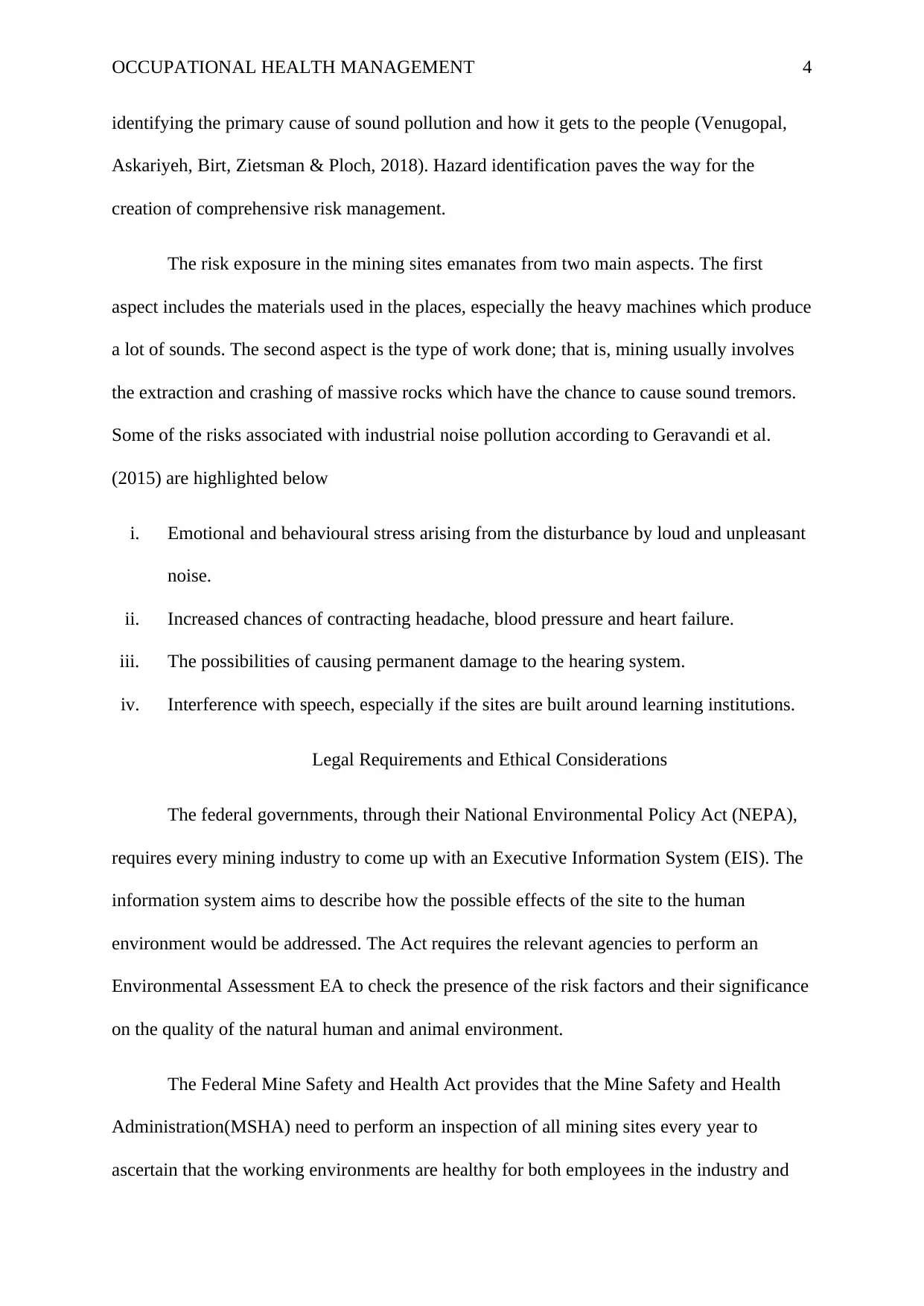
OCCUPATIONAL HEALTH MANAGEMENT 4
identifying the primary cause of sound pollution and how it gets to the people (Venugopal,
Askariyeh, Birt, Zietsman & Ploch, 2018). Hazard identification paves the way for the
creation of comprehensive risk management.
The risk exposure in the mining sites emanates from two main aspects. The first
aspect includes the materials used in the places, especially the heavy machines which produce
a lot of sounds. The second aspect is the type of work done; that is, mining usually involves
the extraction and crashing of massive rocks which have the chance to cause sound tremors.
Some of the risks associated with industrial noise pollution according to Geravandi et al.
(2015) are highlighted below
i. Emotional and behavioural stress arising from the disturbance by loud and unpleasant
noise.
ii. Increased chances of contracting headache, blood pressure and heart failure.
iii. The possibilities of causing permanent damage to the hearing system.
iv. Interference with speech, especially if the sites are built around learning institutions.
Legal Requirements and Ethical Considerations
The federal governments, through their National Environmental Policy Act (NEPA),
requires every mining industry to come up with an Executive Information System (EIS). The
information system aims to describe how the possible effects of the site to the human
environment would be addressed. The Act requires the relevant agencies to perform an
Environmental Assessment EA to check the presence of the risk factors and their significance
on the quality of the natural human and animal environment.
The Federal Mine Safety and Health Act provides that the Mine Safety and Health
Administration(MSHA) need to perform an inspection of all mining sites every year to
ascertain that the working environments are healthy for both employees in the industry and
identifying the primary cause of sound pollution and how it gets to the people (Venugopal,
Askariyeh, Birt, Zietsman & Ploch, 2018). Hazard identification paves the way for the
creation of comprehensive risk management.
The risk exposure in the mining sites emanates from two main aspects. The first
aspect includes the materials used in the places, especially the heavy machines which produce
a lot of sounds. The second aspect is the type of work done; that is, mining usually involves
the extraction and crashing of massive rocks which have the chance to cause sound tremors.
Some of the risks associated with industrial noise pollution according to Geravandi et al.
(2015) are highlighted below
i. Emotional and behavioural stress arising from the disturbance by loud and unpleasant
noise.
ii. Increased chances of contracting headache, blood pressure and heart failure.
iii. The possibilities of causing permanent damage to the hearing system.
iv. Interference with speech, especially if the sites are built around learning institutions.
Legal Requirements and Ethical Considerations
The federal governments, through their National Environmental Policy Act (NEPA),
requires every mining industry to come up with an Executive Information System (EIS). The
information system aims to describe how the possible effects of the site to the human
environment would be addressed. The Act requires the relevant agencies to perform an
Environmental Assessment EA to check the presence of the risk factors and their significance
on the quality of the natural human and animal environment.
The Federal Mine Safety and Health Act provides that the Mine Safety and Health
Administration(MSHA) need to perform an inspection of all mining sites every year to
ascertain that the working environments are healthy for both employees in the industry and
Paraphrase This Document
Need a fresh take? Get an instant paraphrase of this document with our AI Paraphraser
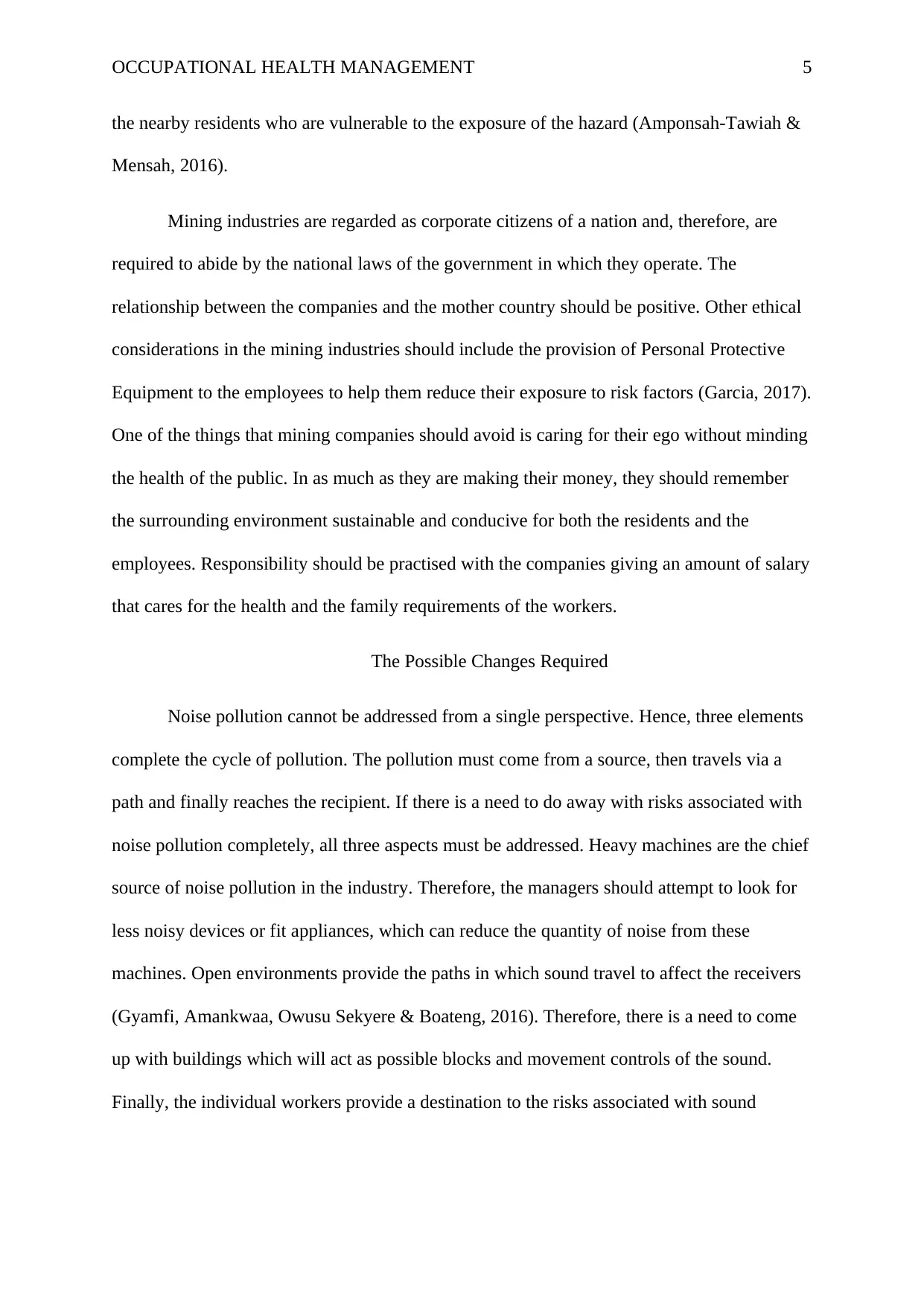
OCCUPATIONAL HEALTH MANAGEMENT 5
the nearby residents who are vulnerable to the exposure of the hazard (Amponsah-Tawiah &
Mensah, 2016).
Mining industries are regarded as corporate citizens of a nation and, therefore, are
required to abide by the national laws of the government in which they operate. The
relationship between the companies and the mother country should be positive. Other ethical
considerations in the mining industries should include the provision of Personal Protective
Equipment to the employees to help them reduce their exposure to risk factors (Garcia, 2017).
One of the things that mining companies should avoid is caring for their ego without minding
the health of the public. In as much as they are making their money, they should remember
the surrounding environment sustainable and conducive for both the residents and the
employees. Responsibility should be practised with the companies giving an amount of salary
that cares for the health and the family requirements of the workers.
The Possible Changes Required
Noise pollution cannot be addressed from a single perspective. Hence, three elements
complete the cycle of pollution. The pollution must come from a source, then travels via a
path and finally reaches the recipient. If there is a need to do away with risks associated with
noise pollution completely, all three aspects must be addressed. Heavy machines are the chief
source of noise pollution in the industry. Therefore, the managers should attempt to look for
less noisy devices or fit appliances, which can reduce the quantity of noise from these
machines. Open environments provide the paths in which sound travel to affect the receivers
(Gyamfi, Amankwaa, Owusu Sekyere & Boateng, 2016). Therefore, there is a need to come
up with buildings which will act as possible blocks and movement controls of the sound.
Finally, the individual workers provide a destination to the risks associated with sound
the nearby residents who are vulnerable to the exposure of the hazard (Amponsah-Tawiah &
Mensah, 2016).
Mining industries are regarded as corporate citizens of a nation and, therefore, are
required to abide by the national laws of the government in which they operate. The
relationship between the companies and the mother country should be positive. Other ethical
considerations in the mining industries should include the provision of Personal Protective
Equipment to the employees to help them reduce their exposure to risk factors (Garcia, 2017).
One of the things that mining companies should avoid is caring for their ego without minding
the health of the public. In as much as they are making their money, they should remember
the surrounding environment sustainable and conducive for both the residents and the
employees. Responsibility should be practised with the companies giving an amount of salary
that cares for the health and the family requirements of the workers.
The Possible Changes Required
Noise pollution cannot be addressed from a single perspective. Hence, three elements
complete the cycle of pollution. The pollution must come from a source, then travels via a
path and finally reaches the recipient. If there is a need to do away with risks associated with
noise pollution completely, all three aspects must be addressed. Heavy machines are the chief
source of noise pollution in the industry. Therefore, the managers should attempt to look for
less noisy devices or fit appliances, which can reduce the quantity of noise from these
machines. Open environments provide the paths in which sound travel to affect the receivers
(Gyamfi, Amankwaa, Owusu Sekyere & Boateng, 2016). Therefore, there is a need to come
up with buildings which will act as possible blocks and movement controls of the sound.
Finally, the individual workers provide a destination to the risks associated with sound
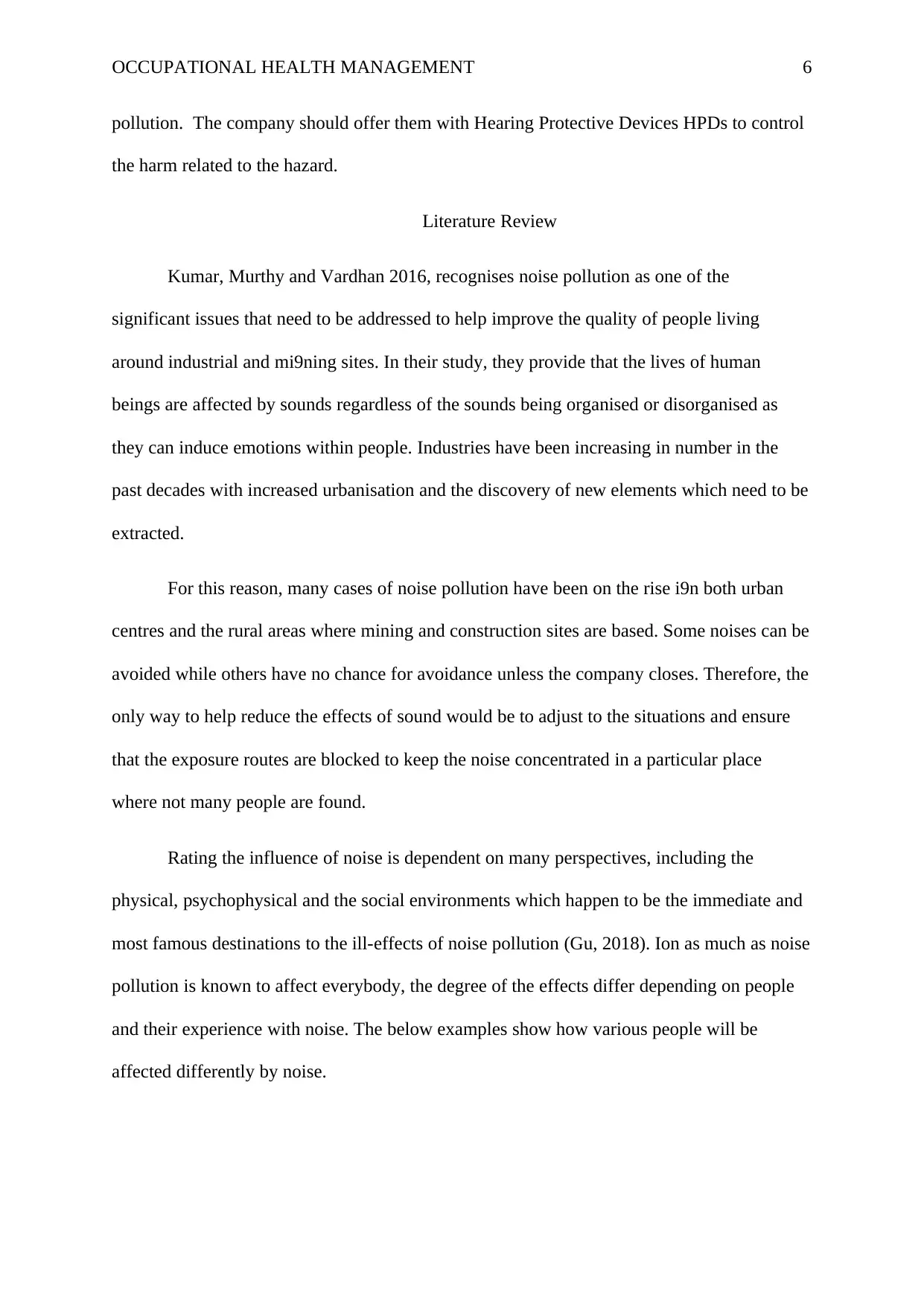
OCCUPATIONAL HEALTH MANAGEMENT 6
pollution. The company should offer them with Hearing Protective Devices HPDs to control
the harm related to the hazard.
Literature Review
Kumar, Murthy and Vardhan 2016, recognises noise pollution as one of the
significant issues that need to be addressed to help improve the quality of people living
around industrial and mi9ning sites. In their study, they provide that the lives of human
beings are affected by sounds regardless of the sounds being organised or disorganised as
they can induce emotions within people. Industries have been increasing in number in the
past decades with increased urbanisation and the discovery of new elements which need to be
extracted.
For this reason, many cases of noise pollution have been on the rise i9n both urban
centres and the rural areas where mining and construction sites are based. Some noises can be
avoided while others have no chance for avoidance unless the company closes. Therefore, the
only way to help reduce the effects of sound would be to adjust to the situations and ensure
that the exposure routes are blocked to keep the noise concentrated in a particular place
where not many people are found.
Rating the influence of noise is dependent on many perspectives, including the
physical, psychophysical and the social environments which happen to be the immediate and
most famous destinations to the ill-effects of noise pollution (Gu, 2018). Ion as much as noise
pollution is known to affect everybody, the degree of the effects differ depending on people
and their experience with noise. The below examples show how various people will be
affected differently by noise.
pollution. The company should offer them with Hearing Protective Devices HPDs to control
the harm related to the hazard.
Literature Review
Kumar, Murthy and Vardhan 2016, recognises noise pollution as one of the
significant issues that need to be addressed to help improve the quality of people living
around industrial and mi9ning sites. In their study, they provide that the lives of human
beings are affected by sounds regardless of the sounds being organised or disorganised as
they can induce emotions within people. Industries have been increasing in number in the
past decades with increased urbanisation and the discovery of new elements which need to be
extracted.
For this reason, many cases of noise pollution have been on the rise i9n both urban
centres and the rural areas where mining and construction sites are based. Some noises can be
avoided while others have no chance for avoidance unless the company closes. Therefore, the
only way to help reduce the effects of sound would be to adjust to the situations and ensure
that the exposure routes are blocked to keep the noise concentrated in a particular place
where not many people are found.
Rating the influence of noise is dependent on many perspectives, including the
physical, psychophysical and the social environments which happen to be the immediate and
most famous destinations to the ill-effects of noise pollution (Gu, 2018). Ion as much as noise
pollution is known to affect everybody, the degree of the effects differ depending on people
and their experience with noise. The below examples show how various people will be
affected differently by noise.
⊘ This is a preview!⊘
Do you want full access?
Subscribe today to unlock all pages.

Trusted by 1+ million students worldwide
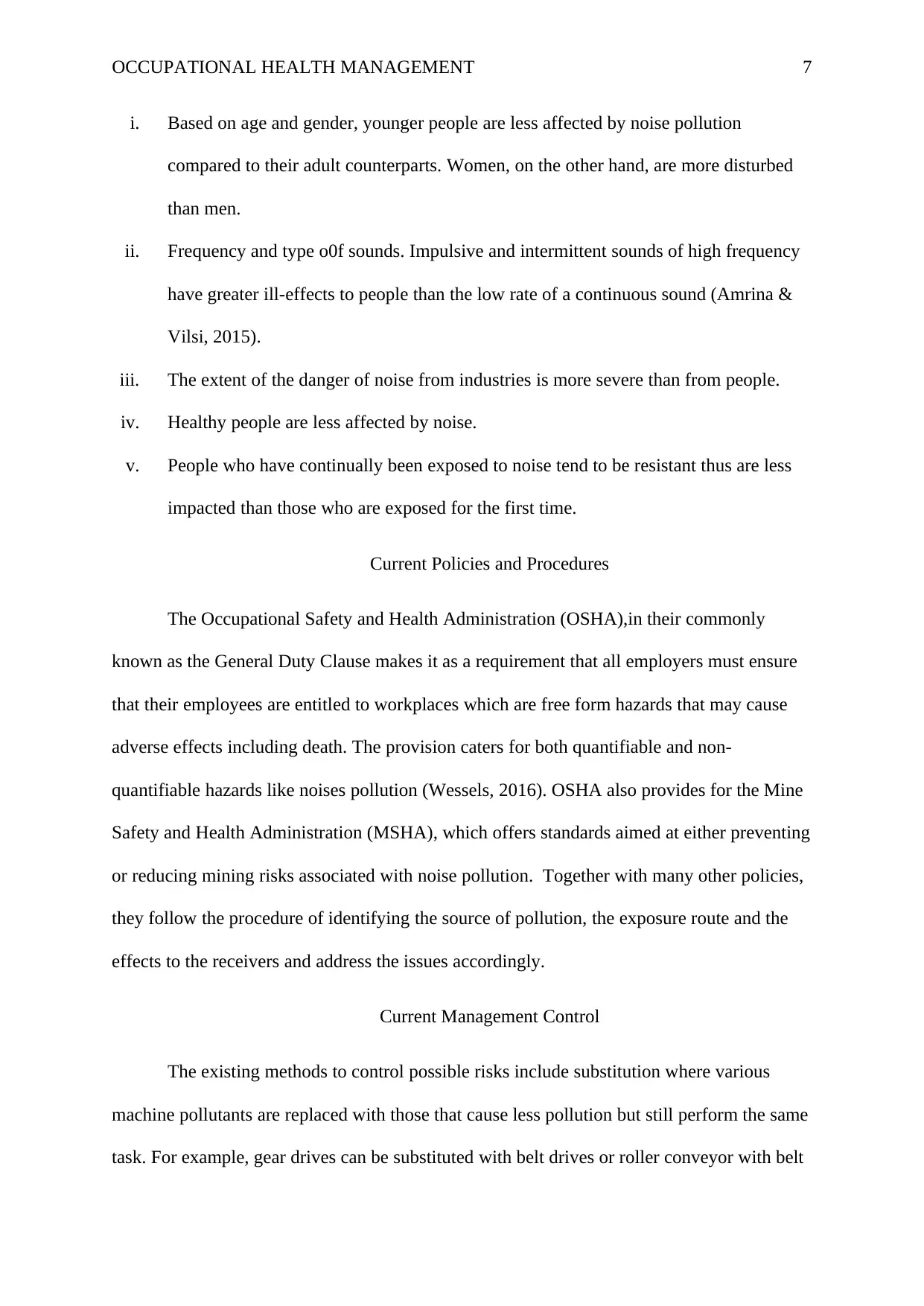
OCCUPATIONAL HEALTH MANAGEMENT 7
i. Based on age and gender, younger people are less affected by noise pollution
compared to their adult counterparts. Women, on the other hand, are more disturbed
than men.
ii. Frequency and type o0f sounds. Impulsive and intermittent sounds of high frequency
have greater ill-effects to people than the low rate of a continuous sound (Amrina &
Vilsi, 2015).
iii. The extent of the danger of noise from industries is more severe than from people.
iv. Healthy people are less affected by noise.
v. People who have continually been exposed to noise tend to be resistant thus are less
impacted than those who are exposed for the first time.
Current Policies and Procedures
The Occupational Safety and Health Administration (OSHA),in their commonly
known as the General Duty Clause makes it as a requirement that all employers must ensure
that their employees are entitled to workplaces which are free form hazards that may cause
adverse effects including death. The provision caters for both quantifiable and non-
quantifiable hazards like noises pollution (Wessels, 2016). OSHA also provides for the Mine
Safety and Health Administration (MSHA), which offers standards aimed at either preventing
or reducing mining risks associated with noise pollution. Together with many other policies,
they follow the procedure of identifying the source of pollution, the exposure route and the
effects to the receivers and address the issues accordingly.
Current Management Control
The existing methods to control possible risks include substitution where various
machine pollutants are replaced with those that cause less pollution but still perform the same
task. For example, gear drives can be substituted with belt drives or roller conveyor with belt
i. Based on age and gender, younger people are less affected by noise pollution
compared to their adult counterparts. Women, on the other hand, are more disturbed
than men.
ii. Frequency and type o0f sounds. Impulsive and intermittent sounds of high frequency
have greater ill-effects to people than the low rate of a continuous sound (Amrina &
Vilsi, 2015).
iii. The extent of the danger of noise from industries is more severe than from people.
iv. Healthy people are less affected by noise.
v. People who have continually been exposed to noise tend to be resistant thus are less
impacted than those who are exposed for the first time.
Current Policies and Procedures
The Occupational Safety and Health Administration (OSHA),in their commonly
known as the General Duty Clause makes it as a requirement that all employers must ensure
that their employees are entitled to workplaces which are free form hazards that may cause
adverse effects including death. The provision caters for both quantifiable and non-
quantifiable hazards like noises pollution (Wessels, 2016). OSHA also provides for the Mine
Safety and Health Administration (MSHA), which offers standards aimed at either preventing
or reducing mining risks associated with noise pollution. Together with many other policies,
they follow the procedure of identifying the source of pollution, the exposure route and the
effects to the receivers and address the issues accordingly.
Current Management Control
The existing methods to control possible risks include substitution where various
machine pollutants are replaced with those that cause less pollution but still perform the same
task. For example, gear drives can be substituted with belt drives or roller conveyor with belt
Paraphrase This Document
Need a fresh take? Get an instant paraphrase of this document with our AI Paraphraser
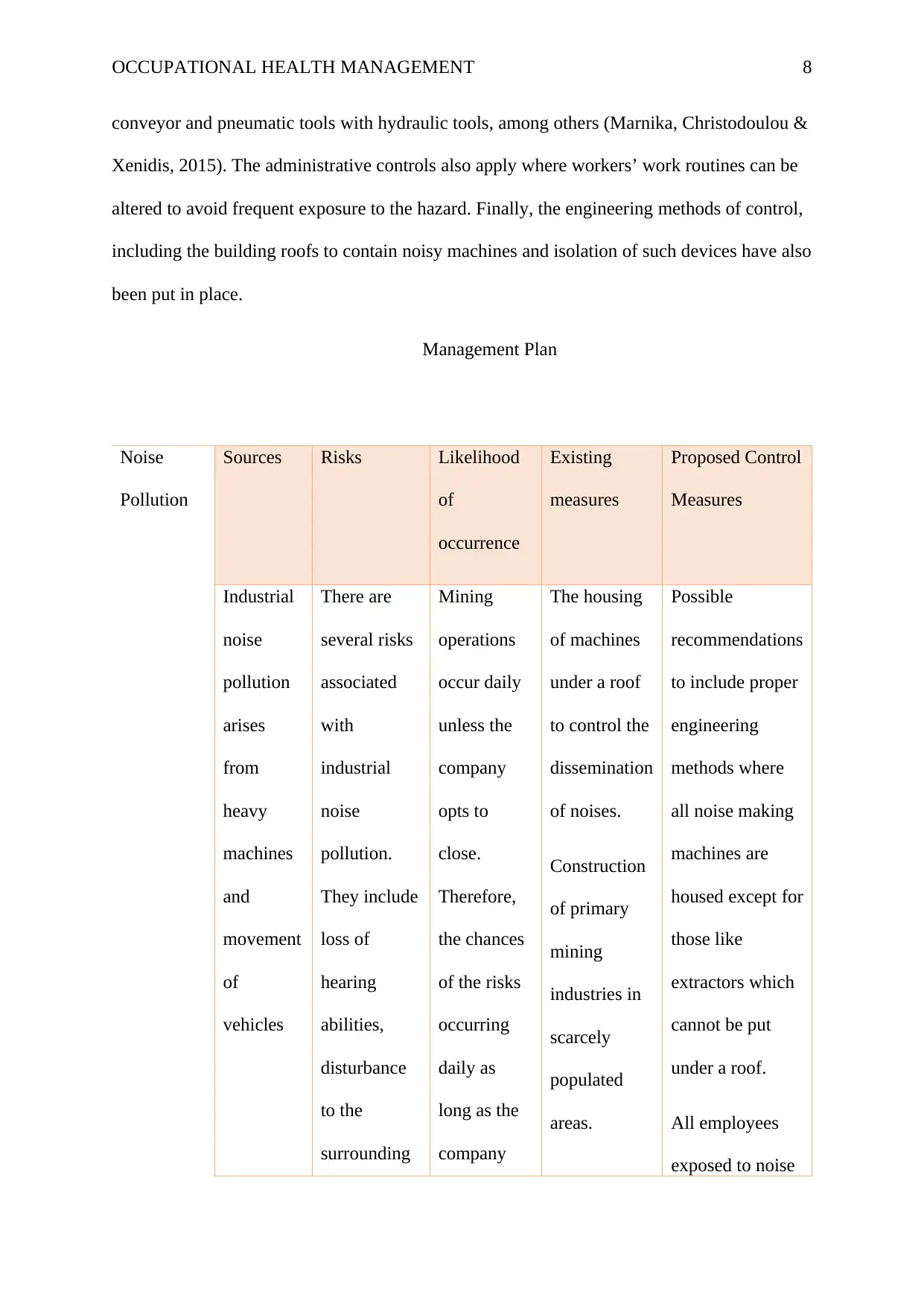
OCCUPATIONAL HEALTH MANAGEMENT 8
conveyor and pneumatic tools with hydraulic tools, among others (Marnika, Christodoulou &
Xenidis, 2015). The administrative controls also apply where workers’ work routines can be
altered to avoid frequent exposure to the hazard. Finally, the engineering methods of control,
including the building roofs to contain noisy machines and isolation of such devices have also
been put in place.
Management Plan
Noise
Pollution
Sources Risks Likelihood
of
occurrence
Existing
measures
Proposed Control
Measures
Industrial
noise
pollution
arises
from
heavy
machines
and
movement
of
vehicles
There are
several risks
associated
with
industrial
noise
pollution.
They include
loss of
hearing
abilities,
disturbance
to the
surrounding
Mining
operations
occur daily
unless the
company
opts to
close.
Therefore,
the chances
of the risks
occurring
daily as
long as the
company
The housing
of machines
under a roof
to control the
dissemination
of noises.
Construction
of primary
mining
industries in
scarcely
populated
areas.
Possible
recommendations
to include proper
engineering
methods where
all noise making
machines are
housed except for
those like
extractors which
cannot be put
under a roof.
All employees
exposed to noise
conveyor and pneumatic tools with hydraulic tools, among others (Marnika, Christodoulou &
Xenidis, 2015). The administrative controls also apply where workers’ work routines can be
altered to avoid frequent exposure to the hazard. Finally, the engineering methods of control,
including the building roofs to contain noisy machines and isolation of such devices have also
been put in place.
Management Plan
Noise
Pollution
Sources Risks Likelihood
of
occurrence
Existing
measures
Proposed Control
Measures
Industrial
noise
pollution
arises
from
heavy
machines
and
movement
of
vehicles
There are
several risks
associated
with
industrial
noise
pollution.
They include
loss of
hearing
abilities,
disturbance
to the
surrounding
Mining
operations
occur daily
unless the
company
opts to
close.
Therefore,
the chances
of the risks
occurring
daily as
long as the
company
The housing
of machines
under a roof
to control the
dissemination
of noises.
Construction
of primary
mining
industries in
scarcely
populated
areas.
Possible
recommendations
to include proper
engineering
methods where
all noise making
machines are
housed except for
those like
extractors which
cannot be put
under a roof.
All employees
exposed to noise
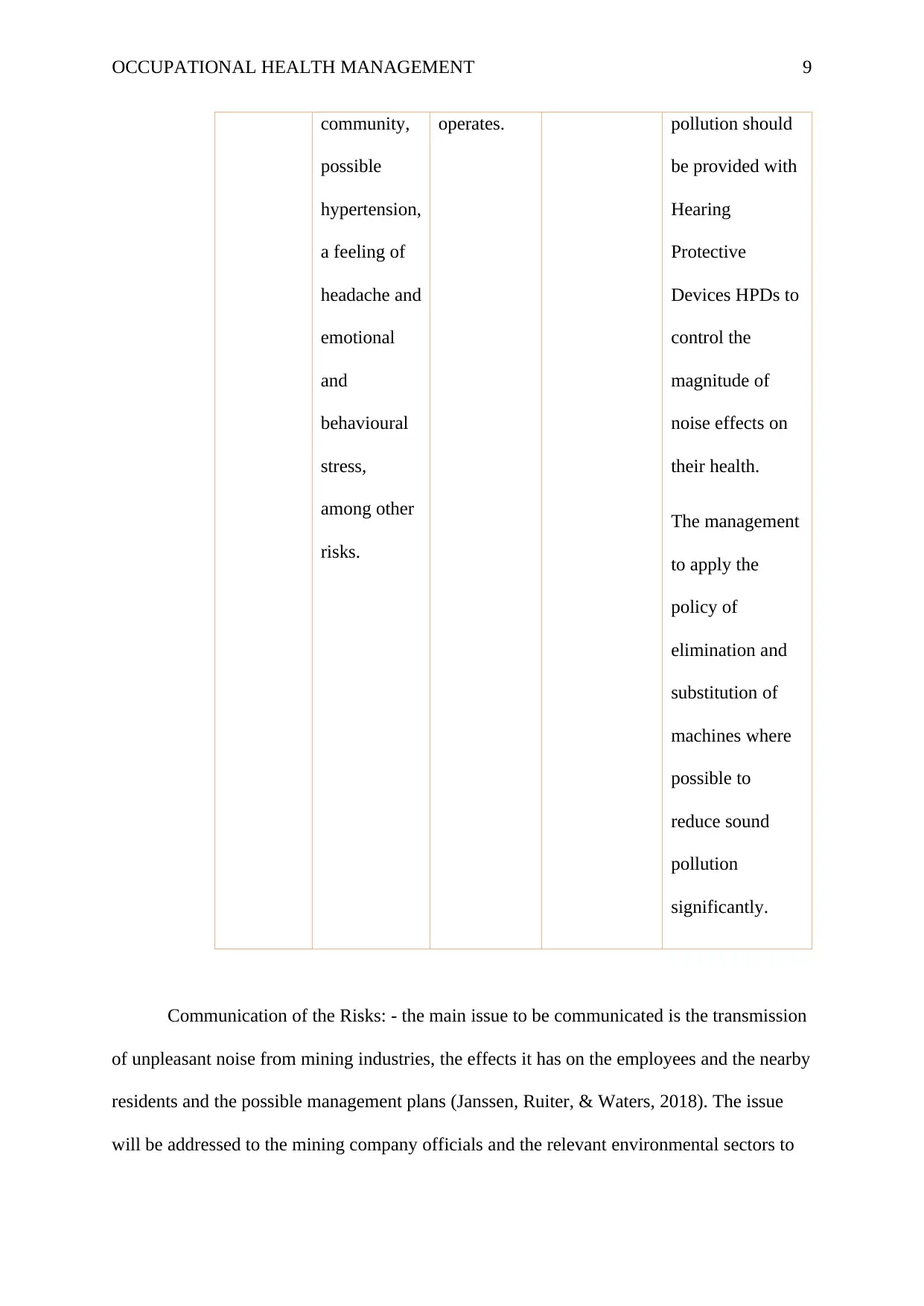
OCCUPATIONAL HEALTH MANAGEMENT 9
community,
possible
hypertension,
a feeling of
headache and
emotional
and
behavioural
stress,
among other
risks.
operates. pollution should
be provided with
Hearing
Protective
Devices HPDs to
control the
magnitude of
noise effects on
their health.
The management
to apply the
policy of
elimination and
substitution of
machines where
possible to
reduce sound
pollution
significantly.
Communication of the Risks: - the main issue to be communicated is the transmission
of unpleasant noise from mining industries, the effects it has on the employees and the nearby
residents and the possible management plans (Janssen, Ruiter, & Waters, 2018). The issue
will be addressed to the mining company officials and the relevant environmental sectors to
community,
possible
hypertension,
a feeling of
headache and
emotional
and
behavioural
stress,
among other
risks.
operates. pollution should
be provided with
Hearing
Protective
Devices HPDs to
control the
magnitude of
noise effects on
their health.
The management
to apply the
policy of
elimination and
substitution of
machines where
possible to
reduce sound
pollution
significantly.
Communication of the Risks: - the main issue to be communicated is the transmission
of unpleasant noise from mining industries, the effects it has on the employees and the nearby
residents and the possible management plans (Janssen, Ruiter, & Waters, 2018). The issue
will be addressed to the mining company officials and the relevant environmental sectors to
⊘ This is a preview!⊘
Do you want full access?
Subscribe today to unlock all pages.

Trusted by 1+ million students worldwide
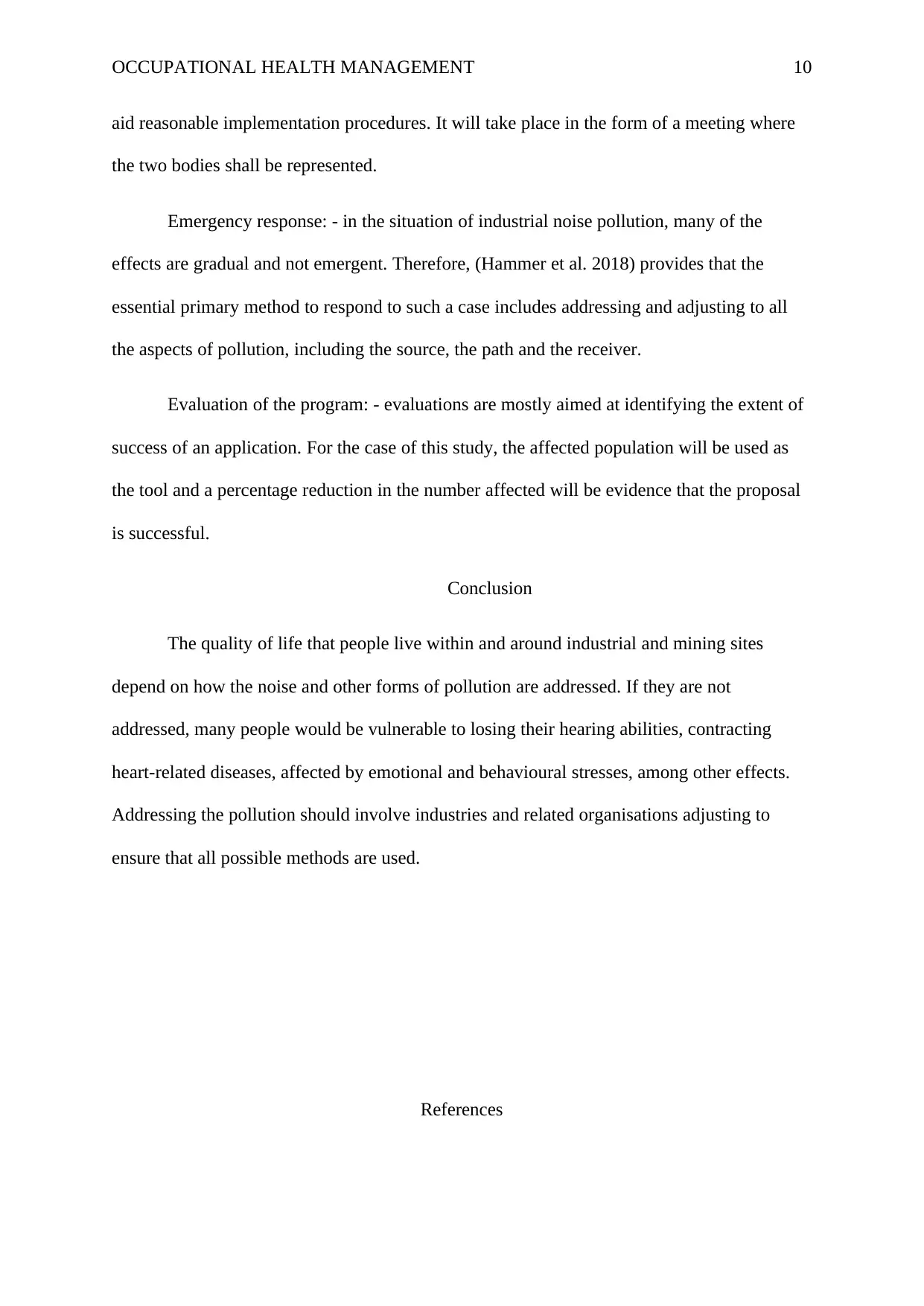
OCCUPATIONAL HEALTH MANAGEMENT 10
aid reasonable implementation procedures. It will take place in the form of a meeting where
the two bodies shall be represented.
Emergency response: - in the situation of industrial noise pollution, many of the
effects are gradual and not emergent. Therefore, (Hammer et al. 2018) provides that the
essential primary method to respond to such a case includes addressing and adjusting to all
the aspects of pollution, including the source, the path and the receiver.
Evaluation of the program: - evaluations are mostly aimed at identifying the extent of
success of an application. For the case of this study, the affected population will be used as
the tool and a percentage reduction in the number affected will be evidence that the proposal
is successful.
Conclusion
The quality of life that people live within and around industrial and mining sites
depend on how the noise and other forms of pollution are addressed. If they are not
addressed, many people would be vulnerable to losing their hearing abilities, contracting
heart-related diseases, affected by emotional and behavioural stresses, among other effects.
Addressing the pollution should involve industries and related organisations adjusting to
ensure that all possible methods are used.
References
aid reasonable implementation procedures. It will take place in the form of a meeting where
the two bodies shall be represented.
Emergency response: - in the situation of industrial noise pollution, many of the
effects are gradual and not emergent. Therefore, (Hammer et al. 2018) provides that the
essential primary method to respond to such a case includes addressing and adjusting to all
the aspects of pollution, including the source, the path and the receiver.
Evaluation of the program: - evaluations are mostly aimed at identifying the extent of
success of an application. For the case of this study, the affected population will be used as
the tool and a percentage reduction in the number affected will be evidence that the proposal
is successful.
Conclusion
The quality of life that people live within and around industrial and mining sites
depend on how the noise and other forms of pollution are addressed. If they are not
addressed, many people would be vulnerable to losing their hearing abilities, contracting
heart-related diseases, affected by emotional and behavioural stresses, among other effects.
Addressing the pollution should involve industries and related organisations adjusting to
ensure that all possible methods are used.
References
Paraphrase This Document
Need a fresh take? Get an instant paraphrase of this document with our AI Paraphraser
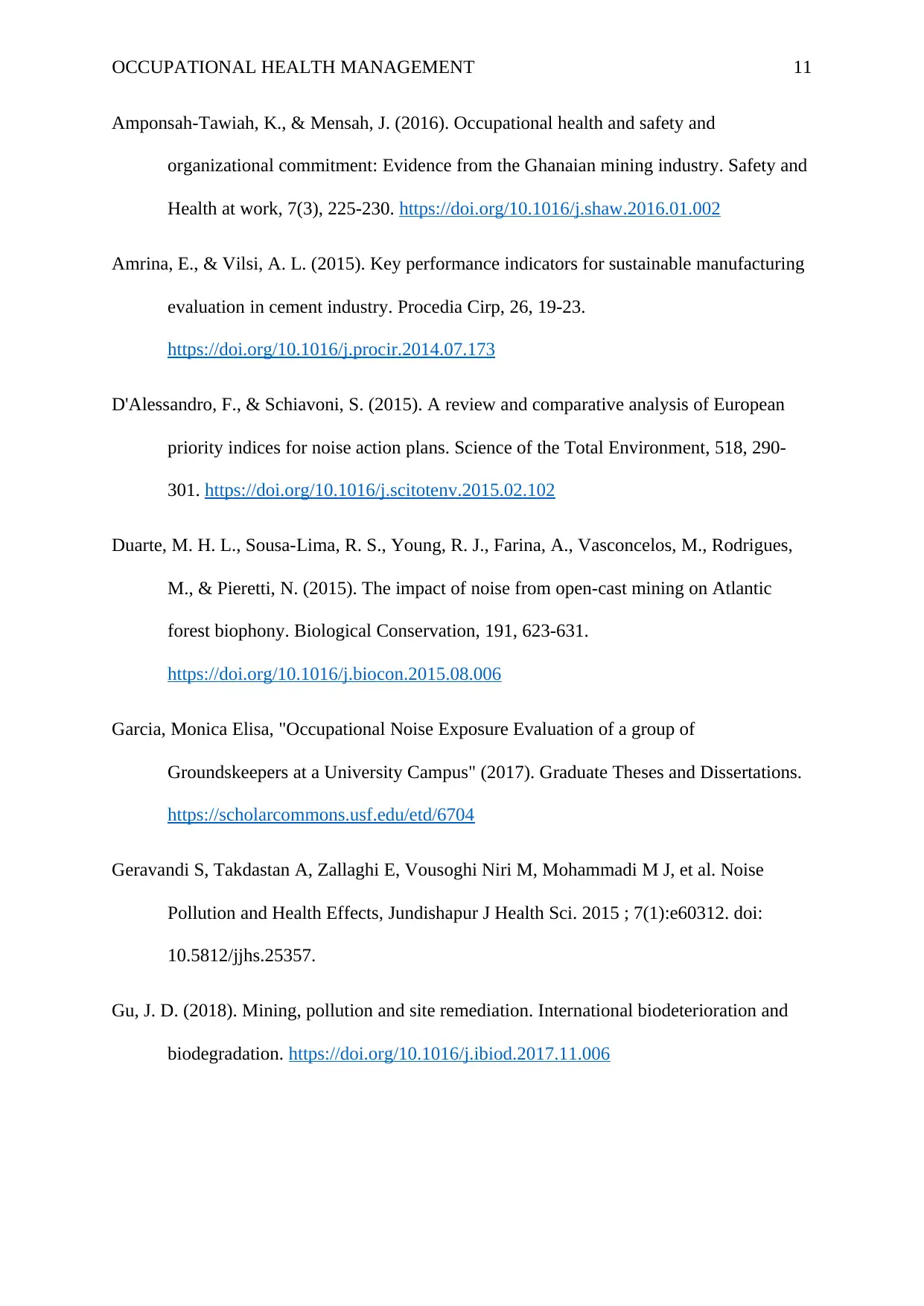
OCCUPATIONAL HEALTH MANAGEMENT 11
Amponsah-Tawiah, K., & Mensah, J. (2016). Occupational health and safety and
organizational commitment: Evidence from the Ghanaian mining industry. Safety and
Health at work, 7(3), 225-230. https://doi.org/10.1016/j.shaw.2016.01.002
Amrina, E., & Vilsi, A. L. (2015). Key performance indicators for sustainable manufacturing
evaluation in cement industry. Procedia Cirp, 26, 19-23.
https://doi.org/10.1016/j.procir.2014.07.173
D'Alessandro, F., & Schiavoni, S. (2015). A review and comparative analysis of European
priority indices for noise action plans. Science of the Total Environment, 518, 290-
301. https://doi.org/10.1016/j.scitotenv.2015.02.102
Duarte, M. H. L., Sousa-Lima, R. S., Young, R. J., Farina, A., Vasconcelos, M., Rodrigues,
M., & Pieretti, N. (2015). The impact of noise from open-cast mining on Atlantic
forest biophony. Biological Conservation, 191, 623-631.
https://doi.org/10.1016/j.biocon.2015.08.006
Garcia, Monica Elisa, "Occupational Noise Exposure Evaluation of a group of
Groundskeepers at a University Campus" (2017). Graduate Theses and Dissertations.
https://scholarcommons.usf.edu/etd/6704
Geravandi S, Takdastan A, Zallaghi E, Vousoghi Niri M, Mohammadi M J, et al. Noise
Pollution and Health Effects, Jundishapur J Health Sci. 2015 ; 7(1):e60312. doi:
10.5812/jjhs.25357.
Gu, J. D. (2018). Mining, pollution and site remediation. International biodeterioration and
biodegradation. https://doi.org/10.1016/j.ibiod.2017.11.006
Amponsah-Tawiah, K., & Mensah, J. (2016). Occupational health and safety and
organizational commitment: Evidence from the Ghanaian mining industry. Safety and
Health at work, 7(3), 225-230. https://doi.org/10.1016/j.shaw.2016.01.002
Amrina, E., & Vilsi, A. L. (2015). Key performance indicators for sustainable manufacturing
evaluation in cement industry. Procedia Cirp, 26, 19-23.
https://doi.org/10.1016/j.procir.2014.07.173
D'Alessandro, F., & Schiavoni, S. (2015). A review and comparative analysis of European
priority indices for noise action plans. Science of the Total Environment, 518, 290-
301. https://doi.org/10.1016/j.scitotenv.2015.02.102
Duarte, M. H. L., Sousa-Lima, R. S., Young, R. J., Farina, A., Vasconcelos, M., Rodrigues,
M., & Pieretti, N. (2015). The impact of noise from open-cast mining on Atlantic
forest biophony. Biological Conservation, 191, 623-631.
https://doi.org/10.1016/j.biocon.2015.08.006
Garcia, Monica Elisa, "Occupational Noise Exposure Evaluation of a group of
Groundskeepers at a University Campus" (2017). Graduate Theses and Dissertations.
https://scholarcommons.usf.edu/etd/6704
Geravandi S, Takdastan A, Zallaghi E, Vousoghi Niri M, Mohammadi M J, et al. Noise
Pollution and Health Effects, Jundishapur J Health Sci. 2015 ; 7(1):e60312. doi:
10.5812/jjhs.25357.
Gu, J. D. (2018). Mining, pollution and site remediation. International biodeterioration and
biodegradation. https://doi.org/10.1016/j.ibiod.2017.11.006
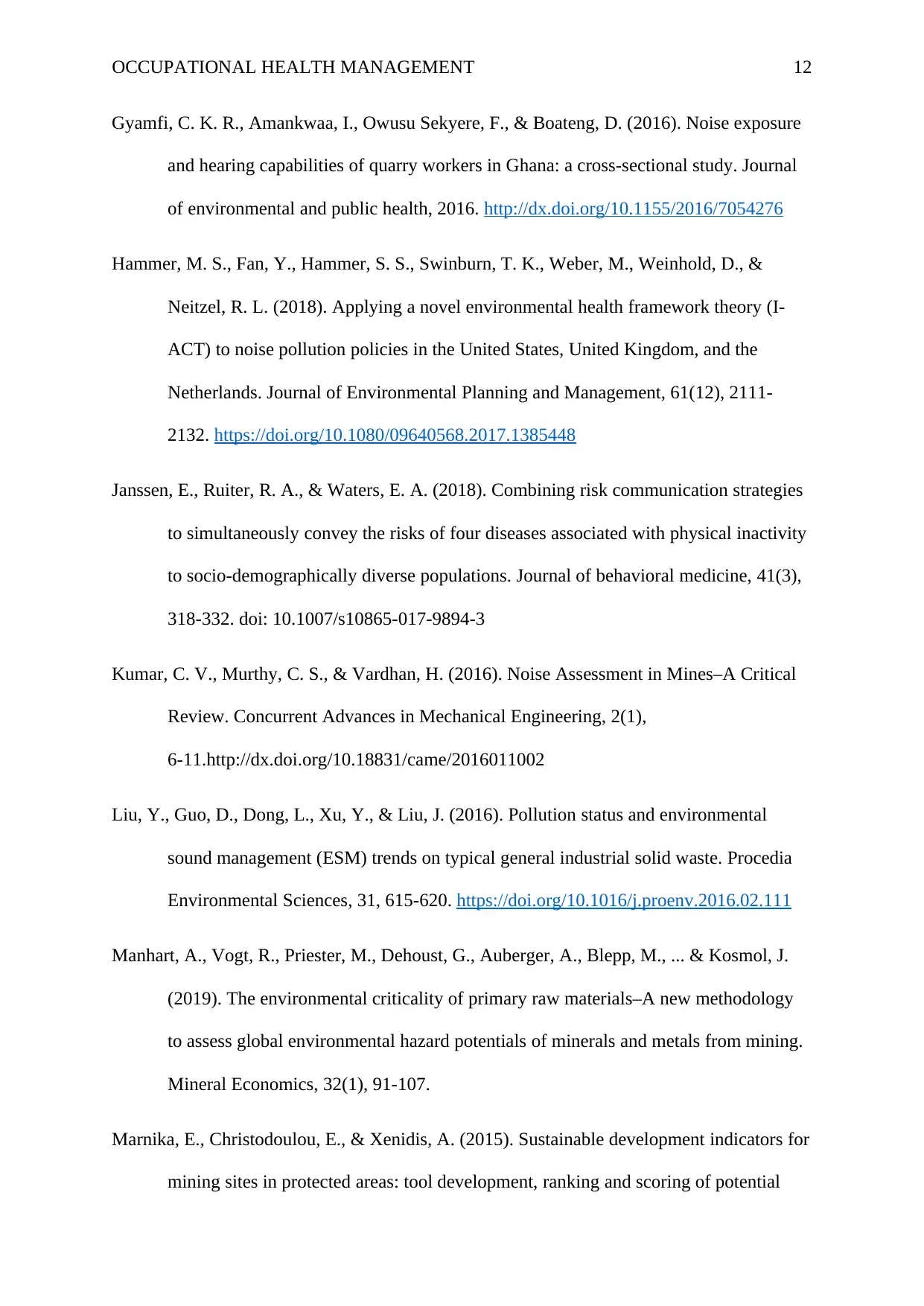
OCCUPATIONAL HEALTH MANAGEMENT 12
Gyamfi, C. K. R., Amankwaa, I., Owusu Sekyere, F., & Boateng, D. (2016). Noise exposure
and hearing capabilities of quarry workers in Ghana: a cross-sectional study. Journal
of environmental and public health, 2016. http://dx.doi.org/10.1155/2016/7054276
Hammer, M. S., Fan, Y., Hammer, S. S., Swinburn, T. K., Weber, M., Weinhold, D., &
Neitzel, R. L. (2018). Applying a novel environmental health framework theory (I-
ACT) to noise pollution policies in the United States, United Kingdom, and the
Netherlands. Journal of Environmental Planning and Management, 61(12), 2111-
2132. https://doi.org/10.1080/09640568.2017.1385448
Janssen, E., Ruiter, R. A., & Waters, E. A. (2018). Combining risk communication strategies
to simultaneously convey the risks of four diseases associated with physical inactivity
to socio-demographically diverse populations. Journal of behavioral medicine, 41(3),
318-332. doi: 10.1007/s10865-017-9894-3
Kumar, C. V., Murthy, C. S., & Vardhan, H. (2016). Noise Assessment in Mines–A Critical
Review. Concurrent Advances in Mechanical Engineering, 2(1),
6-11.http://dx.doi.org/10.18831/came/2016011002
Liu, Y., Guo, D., Dong, L., Xu, Y., & Liu, J. (2016). Pollution status and environmental
sound management (ESM) trends on typical general industrial solid waste. Procedia
Environmental Sciences, 31, 615-620. https://doi.org/10.1016/j.proenv.2016.02.111
Manhart, A., Vogt, R., Priester, M., Dehoust, G., Auberger, A., Blepp, M., ... & Kosmol, J.
(2019). The environmental criticality of primary raw materials–A new methodology
to assess global environmental hazard potentials of minerals and metals from mining.
Mineral Economics, 32(1), 91-107.
Marnika, E., Christodoulou, E., & Xenidis, A. (2015). Sustainable development indicators for
mining sites in protected areas: tool development, ranking and scoring of potential
Gyamfi, C. K. R., Amankwaa, I., Owusu Sekyere, F., & Boateng, D. (2016). Noise exposure
and hearing capabilities of quarry workers in Ghana: a cross-sectional study. Journal
of environmental and public health, 2016. http://dx.doi.org/10.1155/2016/7054276
Hammer, M. S., Fan, Y., Hammer, S. S., Swinburn, T. K., Weber, M., Weinhold, D., &
Neitzel, R. L. (2018). Applying a novel environmental health framework theory (I-
ACT) to noise pollution policies in the United States, United Kingdom, and the
Netherlands. Journal of Environmental Planning and Management, 61(12), 2111-
2132. https://doi.org/10.1080/09640568.2017.1385448
Janssen, E., Ruiter, R. A., & Waters, E. A. (2018). Combining risk communication strategies
to simultaneously convey the risks of four diseases associated with physical inactivity
to socio-demographically diverse populations. Journal of behavioral medicine, 41(3),
318-332. doi: 10.1007/s10865-017-9894-3
Kumar, C. V., Murthy, C. S., & Vardhan, H. (2016). Noise Assessment in Mines–A Critical
Review. Concurrent Advances in Mechanical Engineering, 2(1),
6-11.http://dx.doi.org/10.18831/came/2016011002
Liu, Y., Guo, D., Dong, L., Xu, Y., & Liu, J. (2016). Pollution status and environmental
sound management (ESM) trends on typical general industrial solid waste. Procedia
Environmental Sciences, 31, 615-620. https://doi.org/10.1016/j.proenv.2016.02.111
Manhart, A., Vogt, R., Priester, M., Dehoust, G., Auberger, A., Blepp, M., ... & Kosmol, J.
(2019). The environmental criticality of primary raw materials–A new methodology
to assess global environmental hazard potentials of minerals and metals from mining.
Mineral Economics, 32(1), 91-107.
Marnika, E., Christodoulou, E., & Xenidis, A. (2015). Sustainable development indicators for
mining sites in protected areas: tool development, ranking and scoring of potential
⊘ This is a preview!⊘
Do you want full access?
Subscribe today to unlock all pages.

Trusted by 1+ million students worldwide
1 out of 13
Your All-in-One AI-Powered Toolkit for Academic Success.
+13062052269
info@desklib.com
Available 24*7 on WhatsApp / Email
![[object Object]](/_next/static/media/star-bottom.7253800d.svg)
Unlock your academic potential
Copyright © 2020–2025 A2Z Services. All Rights Reserved. Developed and managed by ZUCOL.

